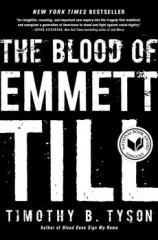The Blood of Emmett Till
Review
The Blood of Emmett Till
Emmett Till, a recent arrival to Mississippi in 1955 who was living with a local black preacher, fell afoul of white sentiments and race hatred. When he walked into a little store and had words with and maybe touched the proprietor's wife, Carolyn Bryant, he took his first steps to the graveyard. Within days he had been tortured and killed by her husband and brother-in-law. His brutal, reasonless death engendered protests and galvanized African Americans at a pivotal moment in their history.
Till was a 14-year-old African American with a mild stutter who had grown up in Chicago, affable and possibly prone to pranks, somewhat unfamiliar with Southern ways. Carolyn Bryant was an attractive dark-haired young woman, born and raised in Mississippi mores, whose presence alone in the family store made her easy prey. Now in her 70s, she is far more reticent regarding the exact circumstances of her encounter with Till than in 1955 when she told a wild, rambling story to an all-white, all-male jury that soon acquitted her kinsmen. Perhaps time has dimmed her memory, or she regrets her part in Till's demise, or maybe, as southern author/historian Timothy Tyson willingly speculates, all of us have faulty memories tinged with subconscious impressions and biases. As he compiled this new book, Bryant was willing to state, "Nothing that boy did could ever justify what happened to him."
"Tyson has trawled diligently through supposedly 'lost' trial records and interviewed those still living who were involved in the crime."
Tyson has trawled diligently through supposedly "lost" trial records and interviewed those still living who were involved in the crime. The perpetrators kidnapped Till in the early hours of the morning, beat him violently and repeatedly, and finally shot him and weighted his body to cast it in the Tallahatchie River. When exhumed, the corpse was all but unrecognizable. Till's mother, Mamie Till Bradley, came down from Chicago and insisted on an open casket funeral "to make her son's death meaningful in a way that his life hadn't had time to be."
The ensuing media attention, especially television coverage, rare and heady for the times, inspired and empowered African Americans all over the US. The rapidly expanding NAACP held rallies attended by thousands, at times showcasing Till's mother. After the trial and acquittal, Look magazine promoted an article by Alabama novelist William Bradford Huie, who framed the "Shocking Story of Approved Killing in Mississippi." Since they were now free from further prosecution, Huie offered the defendants cold cash for their foul confessions; they admitted killing Till while all but blaming him for his own execution because, they said, he kept mocking them while being systematically tortured. Look sold six millions copies of the story, which was later reprinted by Reader's Digest, garnering another 11 million readers. Rosa Parks, Muhammed Ali, Julian Bond and others recalled the Till murder as crucial to their own perceptions of the deep race divide in America.
In reframing this tragic tale, Tyson (author of BLOOD DONE SIGN MY NAME, an account of a similar, less publicized incident in his hometown) reminds us starkly that there was a time when American blacks, in the South and elsewhere, lived in grinding poverty and near-constant fear. And in some ways, for some of them, life hasn't improved as it should have, and certainly not at the pace and to the degree that it has improved for other groups. The specter of white supremacy has raised its head again, with recent incidents such as the Charleston, SC church shooting making it impossible to ignore. Tyson somberly concludes, "To see beyond the ghosts, all of us must develop the moral vision and political will to crush white supremacy --- both the political program and the concealed assumptions."
Reviewed by Barbara Bamberger Scott on February 1, 2017
The Blood of Emmett Till
- Publication Date: December 5, 2017
- Genres: History, Nonfiction
- Paperback: 304 pages
- Publisher: Simon & Schuster
- ISBN-10: 1476714851
- ISBN-13: 9781476714851





